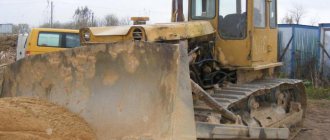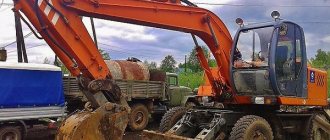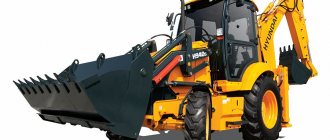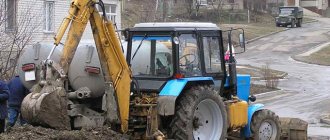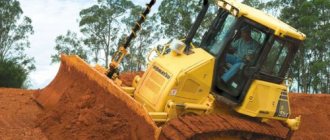Calculation of excavator performance. Options
There are two ways to calculate productivity: experience and reference data. In our company, we imagine what volumes can be counted on for each piece of equipment. You can consult by calling us. Or use reference books for preparing estimates, for example, Moscow TSN-2001 (Territorial estimate standards for Moscow):
for soils of categories 1-3 for development of 100 cubic meters. soil will be swept away (to the dump) with a crawler hydraulic excavator with a 1.0 cubic meter bucket. m. (for example, Hitachi ZX 200, JCB JS 220) 2.2195 machine hours are required, then:
- The excavator's productivity for an 8-hour work shift will be -
360 cc m. The productivity of the excavator with loading into dump trucks is –
From our experience the following data. The backhoe bucket is used for digging trenches and pits. The productivity of soil excavation into the dump under optimal operating conditions is 350 - 400 cubic meters. m per shift for 8 hours. The output varies depending on the digging depth; at the maximum level it decreases by 20%. The complex geometry of excavation work, as well as the need to load soil, reduces productivity by 10 - 15%.
Simpler operations include loading soil from a dump. With proper dispatch of dump trucks, production is within the range of 500 - 600 cubic meters. m.
There is also such an indicator as: the operational performance of an excavator. Its calculation is carried out to determine the efficiency of a mining enterprise based on the results of its activities. Takes into account production, working time utilization rate, and, accordingly, any downtime.
| Photos of equipment | Name | Rent terms | Price per hour | Price per shift |
| Excavator JCB JS 220 bucket 1.2 cubic meters | more than 15 shifts, price including VAT | 2,000 rub. | 16,000 rub. | |
| Excavator Hitachi ZX 200 bucket 1.3 cubic meters. | more than 15 shifts, price including VAT | 2,000 rub. | 16,000 rub. |
Order cubic excavators from our company.
High-performance machines with professional excavator operators. Order
The technical performance of an excavator depends on several factors:
- volume of working equipment. Naturally, the performance of an excavator depends on the volume and purpose of the bucket. Obviously, the larger the bucket, the higher the soil loading speed and the shorter the excavation time. It is necessary to pay attention to the purpose of the bucket, to distinguish, for example, the purpose of a leveling bucket, a trench bucket, a rock bucket, a reinforced bucket, etc.;
- organization of work. Dispatching is the main resource for increasing work productivity. A specialist interested in the result will set up the work in such a way that there will be the smallest possible unloading distance, the best pit development scheme, optimal access for dump trucks and their distribution on the line. The performance of the excavator in this case will be close to operational;
- driver's professionalism. This is probably the main subjective performance parameter. In the practice of our company, almost always an old customer applies for an excavator, subject to the condition of the previous driver. There was a case when two identical excavators from different companies were working at one site, while our company’s machine produced a volume 1.5 times greater, primarily due to the work of our professional driver;
- the novelty of the excavator. Each new model, even within the same brand, is innovative and has increased productivity due to the modernization of components and assemblies and optimization of operations management. The new machine does not break down and does not miss deadlines and tasks;
- soil characteristics. Obviously, the speed of excavation work depends on the severity and hardness of the soil. Also, the water saturation of clays complicates the processes. Viscous, plastic clays do not crumble in the dump truck body, occupying less volume, and stick to the bucket;
- weather. Objective factor - the worse the weather: rain, snowfall, severe frost, the more difficult it is to carry out the work.
We offer JCB / Hitachi crawler excavators for rent for long-term excavation work in the Istra region, Pavlovskaya Sloboda, Krasnogorsk, Nakhabino, Istra, Dedovsk, Snegiry and other cities of the Moscow region.
ETKS. Excavator operator 4 - 8 categories (§ 115 - § 119)
Regulatory documents > ETKS > Issue 3, section “Construction, installation and repair work” > Tariff and qualification characteristics > Excavator operator 4 - 8 categories (§ 115 - § 119)
- § 115. Excavator operator of the 4th category
- § 116. Excavator operator of the 5th category
- § 117. Excavator operator, 6th category
- § 118. Excavator operator, 7th category
- § 119. Excavator operator, 8th category
Professional standard: Excavator operator 4 - 8 categories
Excavator driver
Characteristics of work
- Carrying out work with single-bucket excavators with a bucket and bucket wheel excavators, the capacity and productivity of which are specified in §§ 115 - 119.
- Development of soils for the construction of excavations, embankments, reserves, cavaliers and banquets during the construction of highways, irrigation and shipping canals, dams, protective earthen dams.
- Development of pits for buildings and structures, during the construction of supports for power lines and contact networks.
- Digging trenches for underground communications, drainage ditches, upland and off-bank ditches and other similar structures.
Must know:
- design, operating principle and technical characteristics of excavators;
- operating principle of mechanical, hydraulic and electrical equipment;
- rules for installing and dismantling excavator attachments;
- causes of malfunctions and ways to eliminate them;
- rules for developing soils of various categories at different depths of the face;
- rules for soil development in compliance with specified profiles and elevations.
§ 115. Excavator operator 4th category
Professional standard: Excavator operator 4th category
Single-bucket excavators with a bucket capacity of up to 0.15 m3.
Characteristics of work
- Carrying out work with single-bucket excavators with a bucket and bucket wheel excavators, the capacity and productivity of which are specified in §§ 115 - 119.
- Development of soils for the construction of excavations, embankments, reserves, cavaliers and banquets during the construction of highways, irrigation and shipping canals, dams, protective earthen dams.
- Development of pits for buildings and structures, during the construction of supports for power lines and contact networks.
- Digging trenches for underground communications, drainage ditches, upland and off-bank ditches and other similar structures.
Must know:
- design, operating principle and technical characteristics of excavators;
- operating principle of mechanical, hydraulic and electrical equipment;
- rules for installing and dismantling excavator attachments;
- causes of malfunctions and ways to eliminate them;
- rules for developing soils of various categories at different depths of the face;
- rules for soil development in compliance with specified profiles and elevations.
§ 116. Excavator operator 5th category
Professional standard: Excavator operator of the 5th category
Single-bucket excavators with a bucket capacity of over 0.15 m3 to 0.4 m3. Rotary excavators (ditch diggers and trenchers) with a capacity of up to 1000 m3/h.
Characteristics of work
- Carrying out work with single-bucket excavators with a bucket and bucket wheel excavators, the capacity and productivity of which are specified in §§ 115 - 119.
- Development of soils for the construction of excavations, embankments, reserves, cavaliers and banquets during the construction of highways, irrigation and shipping canals, dams, protective earthen dams.
- Development of pits for buildings and structures, during the construction of supports for power lines and contact networks.
- Digging trenches for underground communications, drainage ditches, upland and zabanquet ditches and other similar structures.
Must know:
- design, operating principle and technical characteristics of excavators;
- operating principle of mechanical, hydraulic and electrical equipment;
- rules for installing and dismantling excavator attachments;
- causes of malfunctions and ways to eliminate them;
- rules for developing soils of various categories at different depths of the face;
- rules for soil development in compliance with specified profiles and elevations.
§ 117. Excavator operator 6th category
Professional standard: Excavator operator, 6th category
Single-bucket excavators with a bucket capacity of over 0.4 m3 to 1.25 m3. Rotary excavators (ditch diggers and trenchers) with a productivity of over 1000 m3/h to 2500 m3/h.
Characteristics of work
- Carrying out work with single-bucket excavators with a bucket and bucket wheel excavators, the capacity and productivity of which are specified in §§ 115 - 119.
- Development of soils for the construction of excavations, embankments, reserves, cavaliers and banquets during the construction of highways, irrigation and shipping canals, dams, protective earthen dams.
- Development of pits for buildings and structures, during the construction of supports for power lines and contact networks.
- Digging trenches for underground communications, drainage ditches, upland and off-bank ditches and other similar structures.
Must know:
- design, operating principle and technical characteristics of excavators;
- operating principle of mechanical, hydraulic and electrical equipment;
- rules for installing and dismantling excavator attachments;
- causes of malfunctions and ways to eliminate them;
- rules for developing soils of various categories at different depths of the face;
- rules for soil development in compliance with specified profiles and elevations.
§ 118. Excavator operator 7th category
Professional standard: Excavator operator, 7th category
Single-bucket excavators with a bucket capacity of over 1.25 m3 to 4 m3. Rotary excavators with a capacity of over 2500 m3/h to 4500 m3/h.
Characteristics of work
- Carrying out work with single-bucket excavators with a bucket and bucket wheel excavators, the capacity and productivity of which are specified in §§ 115 - 119.
- Development of soils for the construction of excavations, embankments, reserves, cavaliers and banquets during the construction of highways, irrigation and shipping canals, dams, protective earthen dams.
- Development of pits for buildings and structures, during the construction of supports for power lines and contact networks.
- Digging trenches for underground communications, drainage ditches, upland and off-bank ditches and other similar structures.
Must know:
- design, operating principle and technical characteristics of excavators;
- operating principle of mechanical, hydraulic and electrical equipment;
- rules for installing and dismantling excavator attachments;
- causes of malfunctions and ways to eliminate them;
- rules for developing soils of various categories at different depths of the face;
- rules for soil development in compliance with specified profiles and elevations.
Secondary vocational education required.
§ 119. Excavator operator 8th category
Professional standard: 8th category excavator operator
Single-bucket excavators with a bucket capacity of over 4 m3 to 9 m3. Rotary excavators with a capacity of over 4500 m3/h.
Characteristics of work
- Carrying out work with single-bucket excavators with a bucket and bucket wheel excavators, the capacity and productivity of which are specified in §§ 115 - 119.
- Development of soils for the construction of excavations, embankments, reserves, cavaliers and banquets during the construction of highways, irrigation and shipping canals, dams, protective earthen dams.
- Development of pits for buildings and structures, during the construction of supports for power lines and contact networks.
- Digging trenches for underground communications, drainage ditches, upland and off-bank ditches and other similar structures.
Must know:
- design, operating principle and technical characteristics of excavators;
- operating principle of mechanical, hydraulic and electrical equipment;
- rules for installing and dismantling excavator attachments;
- causes of malfunctions and ways to eliminate them;
- rules for developing soils of various categories at different depths of the face;
- rules for soil development in compliance with specified profiles and elevations.
Excavator: productivity m3 per hour, cost of services
The need for special equipment services arises in almost every sector of economic activity or for private needs. One-time use of an excavator does not imply its purchase, so you can use the services of a rented excavator. To calculate the cost of services, an indicator of excavator performance is used, which is important when choosing equipment to perform certain jobs, taking into account their urgency and volume.
What is excavator performance
The main function of the excavator is work related to excavation, moving to the unloading site and forming an embankment or unloading. To calculate the performance of an excavator, it is calculated taking into account all the variables and constant indicators in its operation. The productivity of an excavator is the volume and quantity of work that it can perform in a given time period.
The full cycle of operation of an excavator consists of the following steps:
- lowering the bucket;
- soil development;
- putting soil into a bucket;
- lifting a loaded bucket;
- turning with moving the cargo to the unloading point;
- soil unloading;
- returning the bucket to its original position for further work.
The excavator can perform other types of work, but the main essence of the cycle remains the same.
For a more detailed calculation of performance, many variable indicators are taken into account, on the basis of which formulas are compiled. When calculating the performance of an excavator, the following variables and characteristics are taken into account:
- bucket volume;
- number of cycles over a period of time;
- soil loosening coefficient;
- development size factor;
- machine operating coefficient.
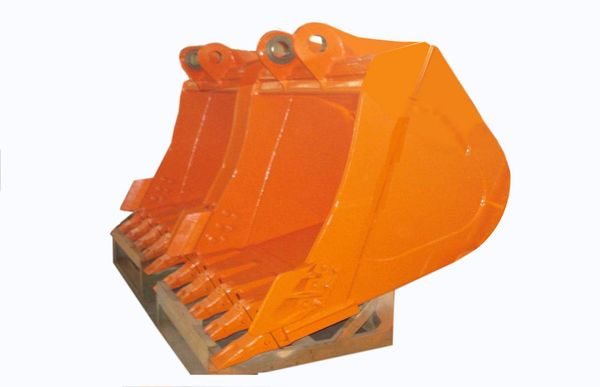
The duration of one full cycle of excavator operation takes several seconds. When calculating productivity, the number of cycles per hour is calculated. The final result is expressed in m3/hour, which is the standard when calculating the productivity of an excavator and further converting this indicator into a shift interval.
How is performance calculated?
Calculations of the efficiency of excavator equipment cannot be unambiguous and take into account all the variables that influence the result.
Therefore, it is common to distinguish between the following three types of performance:
- Theoretical (constructive) - calculation of the amount of work performed by an excavator per hour without taking into account downtime and stops. This is a perfect calculation on paper without taking into account additional variable factors. It is calculated by the formula: Wtheor = Q/Tc, where Q is the volume of the bucket in m3, Tc is the minimum cycle duration in hours.
- Technical – calculation of the largest volume of work, taking into account mining conditions, soil conditions and driver qualifications. It is calculated by the formula: Wtech = Q x Kn/Ttt x Kr, where Q is the volume of the bucket, Ttt is the duration of the work cycle, Kn is the bucket filling coefficient, Kr is the soil loosening coefficient.
- Operational – used to assign standards and carry out general calculations. In the calculations, the machine operating factor is added. This is the closest estimate to actual performance and will always be lower than theoretical or technical performance.
Questions to Consider Before Purchasing
Standard size. It is very important to determine what size excavator you need to do the job you need. To do this correctly, experts recommend carefully analyzing a number of issues related to the equipment of the machine, the nature and volume of work that it must perform.
- Selection of bucket. The type and size of the bucket are selected depending on the type of work and the material being processed. To correctly select a bucket and its components - teeth, cutting edges, etc. - you need to know at least three characteristics of the material:
- density (measured in t/m3);
- abrasiveness, i.e. the ability of the material to “abrade” the metal of the ladle. Its service life depends on the correct choice of bucket material and its components. Depending on the purpose, there are different types of buckets, for example: for digging soft soil (earth, clay, gravel or pebbles); for compacted moderately abrasive materials (earth with rock fragments and gravel); for severe working conditions (hard, highly abrasive rocks - granite, basalt);
- soil connectivity (cohesion). The fill factor of the bucket depends on the cohesion of the soil: for example, when excavating wet clay, the bucket will be filled with a high “hill”, and dry sand will lie in a bucket with a “hill” much lower, and the filling factor of the bucket with sand will be less than when excavating clay.
Depending on the required performance (i.e., the amount of material that the excavator must move), the payload (carrying capacity) of the bucket is determined. If the excavator will load dump trucks, the bucket should be selected so that the dump truck can be loaded in 3–6 loading cycles.
Now you can determine the required bucket capacity (volume) using special tables and the following formula:
Bucket Capacity = Load Capacity/ (Fill Factor x Material Density).
Some inexperienced and uninformed owners (especially from the southern republics) try to select the bucket as large as possible - as a result, the hydraulic system and the excavator boom experience excessive loads during operation and quickly fail.
In addition, there is a limitation on stability: with a transverse superstructure, full boom reach and a maximum loaded bucket, the machine must maintain stability with a margin of at least 10%. From this condition, an acceptable combination of bucket and boom length is selected.
An excavator owner should understand how important it is to choose the right bucket. A larger bucket can take more soil at a time, but the speed of the machine will slow down. By using a quick-release adapter, you can also speed up the process of changing buckets, but the digging force will still be reduced. By analyzing these questions, you will be able to more accurately determine what size excavator and bucket you need.
Load capacity at maximum reach. After this, you can choose an excavator that will provide the required lifting capacity. Please note that many excavator manufacturers indicate in the specification the value of “operating weight”, which refers to the total mass of the material, bucket and quick-release adapter at maximum boom reach.
Arrow length. You need to know how far the soil needs to be moved with an excavator - this will allow you to determine the length of the boom and arm. We have already discussed above the condition of machine stability, which is also related to the length of the boom.
Other characteristics of the excavator. Characteristics are selected depending on the type of work that the machine will perform. If this is loading dump trucks, what unloading height should the excavator have? What is the capacity of the dump truck body? Please note that the capacity of dump trucks must be combined with the size of the excavator and the capacity of its bucket.
If an excavator is digging a trench, what should be its depth and width? Based on the specified dimensions, the required digging performance of the excavator is calculated, and the width and capacity of the bucket are selected.
When choosing an excavator for work in the municipal sector, keep in mind that it must be a highly versatile machine, in particular, the excavator must be able to work with a variety of attachments: hydraulic hammers for breaking up asphalt concrete, a hydraulic drill for drilling holes in the ground and a vibrating plate for compacting (the bottom) of trenches . These are the tools most often used in municipal construction work, and the excavator must have sufficient power and reliability to work with this equipment. For municipal work, we can recommend machines with a short rear reach and a blade for backfilling trenches. Utility vehicles must have very good visibility, since they have to work in conditions of limited space.
Equipment. In addition to buckets, excavators can be equipped with many types of heavy and productive attachments; the power of engines and hydraulic drives allows them to be used. After buckets, the most commonly used excavator equipment is hydraulic hammers.
Digging and loading grabs, ripper teeth, lifting hooks, rammers, hydraulic drills, milling cutters, manipulators for laying pipes, pile-driving equipment for fencing, etc., but they are most in demand for large volumes of demolition work.
Find out what work equipment should be on the excavator and analyze the following questions.
Pressure and flow. Are the pressure and flow rates in the excavator's hydraulic system sufficient to operate the necessary attachments?
Single or double circuit wiring. Does the attachment require single-circuit or dual-circuit wiring?
Single-circuit hydromechanical wiring is sufficient to operate a double-jaw bucket, hydraulic hammer, hydraulic drill, rammer, etc. It should be borne in mind that connecting a hydraulic hammer to an excavator is not an easy task and it is not always possible to cope with it on your own; in such cases, you need to contact specialists.
Double-circuit wiring will be required, for example, for hydraulic shears with a rotator. It is advisable to order an additional hydraulic circuit for dual-circuit hitches immediately when purchasing an excavator, since it is necessary to install an additional section of the hydraulic distributor and control.
Auxiliary hydraulic lines must be installed in accordance with the diagram specified by the excavator manufacturer and using original components. Only such modernization will ensure full operation of the equipment and operator comfort, high productivity and fuel efficiency. The use of non-standard connection methods, such as, for example, disconnecting the bucket hydraulic cylinder with three-way valves to operate the hydraulic hammer, is unacceptable, as it is unsafe.
Availability of service support for equipment. It is recommended to choose suppliers who have been present on the Russian market for a long time, who have high-quality equipment, spare parts, and consumables in stock; specialist consultants; good reviews about the equipment from customers; highly qualified service staff; service support around the clock, as well as on weekends and holidays; own repair base; extensive dealer and service network throughout Russia and the CIS countries; the possibility of replacing equipment according to the trade-in scheme (for example, exchanging a worn-out hydraulic hammer for a new one with an additional payment).
Remember that the lack of service support and spare parts makes the equipment almost disposable.
Excavator performance
Excavator productivity is the amount of work performed by the unit in a certain period of time. When calculating, it is divided into theoretical, technical and operational.
Theoretical productivity is the estimated hourly output that a machine can achieve under normal operating conditions at design operating speeds. In general form (at a tilt angle of the excavator platform of 90°), it can be represented by the formula:
where: W teop - theoretical productivity (in m3/hour), q - bucket capacity (in m3), T c - minimum cycle duration under average operating conditions of the excavator (in sec.).
The duration of the operating cycle of the TC consists of a number of individual operations, i.e.
T c = t k +t r +t d +t t +t in +t' r +t' d +t' t +t p +t' p
where: t k - duration of digging (in sec.), t r - duration of acceleration with a loaded bucket (in sec.), t d - duration of uniform movement with a loaded bucket (in sec.), t t - duration of braking with a loaded bucket (in sec.), t in - duration of unloading of the bucket (in sec.), t' p - duration of acceleration with an empty bucket (in juice), t' d - duration of uniform movement with an empty bucket (in sec.), t ' t - duration of braking with an empty bucket (in sec.), t p - total time for turning to the face (in sec.), t' p - total time for turning to unload (in sec.).
Technical productivity is the highest possible output of a machine per hour of continuous operation under certain conditions. It differs from theoretical productivity by taking into account the properties of the soil and the size of the face in which the excavator is used. The influence of the properties of the soil is reflected in the fact that during the separation from the chips, the group is loosened. Therefore, the volume of the ladle is filled with a smaller volume of group than is calculated in a dense body. The influence of soil properties on filling the bucket is taken into account. In addition, if the angle of rotation of the excavator platform is not equal to 90°, then it is necessary to take into account the change in the duration of the cycle.
The cycle duration, and therefore the technical performance of the excavator, is affected by the following:
- soil category (the higher the soil category, the more difficult it is to develop);
- weather conditions (in winter and late autumn, the filling of the bucket with frozen soil decreases due to its sticking to the bucket and freezing on it);
- organization of work and qualifications of an excavator operator.
Technical productivity is determined by the formula:
where: W tech – technical productivity, measured in m3/hour in a dense body, T ct – duration of the excavator operating cycle at the face (in sec.); is determined by timing or is assumed to be equal to T c taking into account the operating conditions, K n is the coefficient of filling the bucket with soil, K p is the coefficient that takes into account the increase in soil volume due to loosening, q is the capacity of the bucket.
The bucket filling coefficient Kn is the ratio of the volume of loosened soil collected into the bucket to the capacity of the bucket; it depends on the design of the bucket and the operating conditions of the excavator; the filling coefficient value is given in table. eleven .
Table 11. The value of the technical productivity coefficients of single-bucket excavators
Greatest analogue K r
I (sandy loam soil) I (peat and plant soil) II (medium loam) III (heavy loam) IV (heavy clay)
What types of crawler excavators are there?
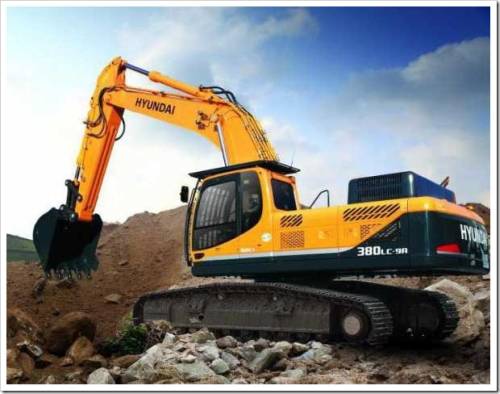
Excavators are classified according to several criteria: number of tracks, drive, purpose, principle of operation.
How many caterpillars do they have?
Based on the number of tracks, equipment is divided into:
- two caterpillar;
- four tracked;
- eight tracked.
What types of drives are there for crawler excavators?
Excavators are divided into:
- electrical;
- diesel;
- hydraulic;
- combined.
Purposes of crawler excavators
- for mining;
- for work in quarries;
- for construction;
- for removing rocks.
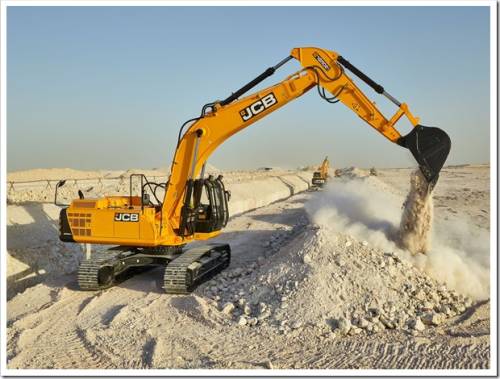
Classification of excavators according to operating principle
- use of a hydraulic hammer;
- loading for transportation;
- continuous operation;
- controlled work.
Depending on the combination of these criteria, an excavator can be assigned to a specific category:
- Mini crawler excavators. They don't take up much space. Suitable for work on small construction sites and in confined spaces.
- The most common models are middle-class excavators. Their range of applications is very wide. Suitable for both small and large-scale jobs.
- For the heaviest work, mining crawler excavators are used. Real giants, capable of digging the deepest foundations and excavating hard-to-reach rocks.
GENERAL PROVISIONS
1.1. These standards are intended to calculate the needs of construction ministries and departments for basic machines for the construction of new facilities related to the relevant sector of the national economy.
1.2. The standards given in table. 1 – 6, set at 1 million rubles. construction and installation work carried out by ministries and departments on their own at prices introduced on January 1, 1969. The standards also take into account the need for machines of manufacturing enterprises on the construction balance sheet.
Note: The need for machines of manufacturing enterprises on the industrial balance sheet is determined by a separate calculation.
1.3. The standards were determined based on the average 1975 indicators of the use of machines, the structure of the mechanization method and the physical volume of work per 1 million rubles. construction and installation works.
Introduced
by the Central Research and Design-Experimental Institute of Organization, Mechanization and Technical Assistance to Construction of the USSR State Construction Committee.
Approved
by the USSR State Construction Committee Decree on April 25, 1977 No. 49 in agreement with the USSR State Planning Committee.
Date of entry into force January 1, 1978.
1.4.
The need for construction machines P when performing construction and installation work for a particular sector of the national economy or industry is determined by multiplying the volume of construction and installation work by the corresponding requirement norm given in Table. 16 :
where О is the volume of construction and installation work carried out on our own, million rubles;
N – the norm of demand for this type of machine per 1 million rubles. construction and installation works, units of the main parameter or pieces.
1.5.
The need for certain types of construction machines when carrying out construction for several sectors of the national economy or industry is determined by calculation using the formula
, (2)
where U is the share of construction and installation work in this industry in the total volume of work, %.
1.6.
If the physical volume of work per 1 million rubles changes. construction and installation work, the structure of mechanization methods and the annual production of machines compared to 1975. The need for machines, calculated according to formula (1), can be adjusted.
The specified PC requirement in this case is determined by the formula
, (3)
where Ko is a coefficient that takes into account the change in the physical volume of work by 1 million rubles. construction and installation works, determined by dividing the volume of work by 1 million rubles. planned (calculated) year for the volume of work in 1975;
K c – coefficient that takes into account changes in the structure of mechanization methods, determined by dividing the specific weight, %, of a given method of work in the total volume of work for the planned (calculated) year by the corresponding indicator for 1975;
K in is a coefficient that takes into account the change in the annual production of machines, determined by dividing the production of machines of the planned (calculated) year by the actual production of machines in 1975.
1.7.
If necessary, the required number of certain types of earth-moving machines, as well as jib and tower cranes, calculated according to the standards, can be replaced by an equivalent number (in terms of productivity) of other types of machines performing similar work.

